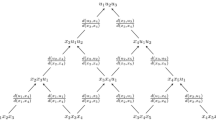Abstract
In geometrical modeling, one is often provided a description of a surface that is defined in terms of a triangulation, which is supported by a discrete number of nodes in space. These faceted surface representations are defined to be C-0 continuous, and therefore in general have slope and curvature discontinuities at the triangle sides, unless the tessellation is planar. Unfortunately, analytical and computational methods often require a surface description that has well-defined and smoothly varying gradients and curvatures; in general spline surfaces possess such properties. Described herein is a process for generating a cubic spline surface that approximates, to within a user-specified tolerance, a given tessellated surface that may be non-convex or multiply connected. The method combines a local least-squares technique for specifying knot properties as well as an adaptation technique for selecting the necessary knot spacings. This new technique is first described along a curve for illustrative purposes. It is then expanded to the case of the general surface. A reparameterization technique that is required for surfaces with non-smooth parameterizations is described next. Computed results for two configurations are then shown.






Similar content being viewed by others
References
Farin G (1990) Curves and surfaces for computer aided geometric design, 2nd edn. Academic Press, New York
Piegl L, Tiller W (1997) The NURBS book, 2nd edn. Springer, Berlin
Jupp DLB (1978) Approximation to data by splines with free knots. SIAM J Numer Anal 15(2):328–343
Eilers PHC, Marx BD (2004) Splines, knots, and penalties. Unpublished.http://www.stat.lsu.edu/faculty/marx/splines_knots_penalties.pdf
Schwetlick H, Schutze T (1995) Least squares approximation by splines with free knots. BIT Numer Math 35(3):361–384
Ruppert D (2002) Selecting the number of knots for penalized splines. J Comput Graph Stat 11(4):735–757
Ferguson D (1986) Construction of curves and surfaces using numerical optimization techniques. Comput Aided Des 18(1):15–21
Press WH, Teukolsky SA, Vetterling WT, Flannery BP (1992) Numerical recipes in Fortran, 2nd edn. Cambridge University Press, London, pp 71–82
Floater MS (2003) Mean value coordinates. Comput Aided Geom Des 20:19–27
Haimes R, Aftosmis MJ (2004) Watertight anisotropic surface meshing using quadrilateral patches. In: 13th international meshing roundtable. http://www.imr.sandia.gov/papers/imr13/haimes.pdf
Acknowledgments
This work was funded by the NASA Fundamental Aeronautics Program under Cooperative Agreement NNX07AV29A. May-Fun Liou is the Technical Monitor.
Author information
Authors and Affiliations
Corresponding author
Rights and permissions
About this article
Cite this article
Dannenhoffer, J.F., Haimes, R. Generation of spline approximations to parametric tessellations. Engineering with Computers 27, 31–40 (2011). https://doi.org/10.1007/s00366-010-0182-x
Received:
Accepted:
Published:
Issue Date:
DOI: https://doi.org/10.1007/s00366-010-0182-x




